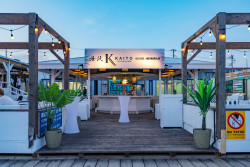
April 15, 2004
Nature Trails
Hakkakuso in Tateyama offers a jumping-off point for cycling, swimming, and the well-preserved charm of Japanese fishing villages. Steve Trautlein heads to the coast.
By Metropolis
Originally published on metropolis.co.jp on April 2004

Photos by David Green
As soon as our van pulls off of Tateyama’s main streets and onto a bumpy dirt road, it’s clear which building we’re headed for. Hakkakuso, unlike the concrete-walled family homes and plastic-covered greenhouses we’ve passed on the trip in, seems almost stately with its brown, angled walls and black-shingled, conical roof. Facing a rice field on one side and a wispy bamboo grove on another, the three-story lodge, boasting large windows and a wraparound deck, seems almost part of the landscape.
Fitting in with nature is easy to do in Tateyama. The waterfront city, two hours from Tokyo, is renowned for its rugged coastline and brilliant flowers. Even in the middle of March, surfers ride the swells, while cycling teams from area schools compete for space on the narrow streets in hills above the coast. Tateyama is intimately connected to the sea through its large fishing industry, its resort hotels, and the Ama-san, female divers who have fished for awabi in local waters for centuries. Hakkakuso itself offers panoramic views from its third floor and sea breezes on its spacious deck.

From the ground up
The lodge is the brainchild of David Green, a science and photography teacher at Nishimachi International School, and Yoshiko Kimura, a teacher at St. Mary’s International School, who built it in 1991. Though they originally intended Hakkakuso as a country retreat for their family and as a place to pursue his cycling hobby, the couple received a hotel and restaurant license eight years ago and began using Tateyama as a kind of base camp for group getaways. These range from weekend company retreats to an annual summer science camp for elementary school students, in addition to popular cycling trips, which vary in length and difficulty depending on the make-up of the participants. “There are enough hills to keep ’em honest,” Green says of the groups he takes out, “but enough flat areas so it’s not too difficult.”
Forested hills and level coastal areas are two of the scenic features that draw visitors to Tateyama from all over Japan. The surrounding Minami Boso Peninsula constitutes the eastern portion of the roughly parallel land masses that join in the north to form Tokyo Bay. Tateyama lies at its southwestern edge—so far, in fact, that it’s almost due south of the metropolitan area and closer to Yokohama than to Tokyo. The city is situated on a small cove, and Green says he’s seen everything from oil tankers to submarines take shelter there during typhoons. Thanks to the peninsula’s outlying position, Minami Boso benefits from a southerly wind that allows its farmers to take advantage of two growing seasons during the year. The same fields that produce the city’s famous flowers from January to April are replanted with soybeans and rice later in spring. The mild weather also means that visitors can enjoy bike trips into November and beyond.

In contrast to the cookie-cutter hotels or tatami-matted ryokan encountered in similar Japanese resort villages, Hakkakuso has an all-wood exterior and interior that gives it a rustic charm. Green decided on the distinctive shape—Hakkakuso is Japanese for “eight-sided lodge”—after learning that the westerly November-January wind rendered his plans for a conventional four-sided building untenable. He used Japanese sugi (cedar) for the exterior, while inside the walls are of American pine and the floors of spruce. The interior is dominated by the daikokubashira, or central column, which rises the entire three stories and whose intricate joints support the ceiling beams. The entire lodge, in fact, is a marvel of Japanese craftsmanship married with Western amenities. “There were very few nails used in the whole place,” Green says, “as is typical of Japanese joinery.”
Green, an amateur chef, whips up meals in a well-appointed Western-style kitchen, or he grills outside on the large deck. A loft space on the upper floor houses two bedrooms and a small library, while downstairs are two bedrooms with six bunk beds—all wood. Just outside the back door sits a self-enclosed Japanese-style bathhouse with a changing room and shower, plus a small annex that holds the 16 mountain bikes that guests can use free of charge. The lodge can accommodate up to 23 guests, and just a ten-minute walk away is the beach and its taste of traditional Japan.
Ever-present
A short drive with Green down the narrow streets of nearby Ainohama fishing village reveals a community with both feet planted firmly in the past. Rusty boats undergoing repair sit at anchor or are dry-docked on ramps leading to the water, while weather-beaten homes and restaurants dot the shore. Ancient women, bent at the waist, amble along the winding roads or tend to the small gardens that everywhere burst with vibrant poppies, rapeseeds and marigolds. Such a colorful but ramshackle assortment of beach houses and shops resonates deeply with the Japanese: besides its fame as a resort, the area served as the backdrop for “Beach Boys,” a 1997 drama about a group of twenty-somethings who run a minshuku, which became one of Japan’s most popular TV shows ever.

Farther along the coast, the towns of Shirahama and Chikura offer rocky beaches with some of Kanto’s best surf, quaint main streets and beachfront hotels. The area’s devotion to—and reliance on—its famous flowers can be seen in the continuous stream of tour buses that disgorge their passengers, mostly groups of obasan, at the stalls and gardens lining the streets. The area also houses the Nambo Paradise, Japan’s second-largest botanical gardens, and a large prefectural sports complex with public tennis courts.
Weekend lodgers at Hakkakuso can also access hiking trails, snorkeling, surfing, and even paragliding and horseback riding. But to Green, the lodge offers quieter moments that are just as rewarding. “Sitting on the deck with a cold beer or some wine with your feet up on the railing, watching the poppies or the rice grow listening to the ocean, works well after a bicycle ride,” he says. To be sure, getting away from it all is a vital part of the Hakkakuso experience.
Contact information
422-1 Sunomiya, Tateyama, Chiba. For lodge availability, rates and other information, contact David Green at dgreen@gol.com or call 03-3708-4012.
Getting there
Traveling between Tokyo and Tateyama stations on a local train costs ¥2,210 (one-way), while the Sazanami limited express train, which runs several times a day, takes less than two hours and costs ¥4,020 (one-way). Free transportation is provided between the station and the lodge. Tateyama is an easy 2.5hr drive via the Tokyo Bay Aqualine.
[geo_mashup_map]







